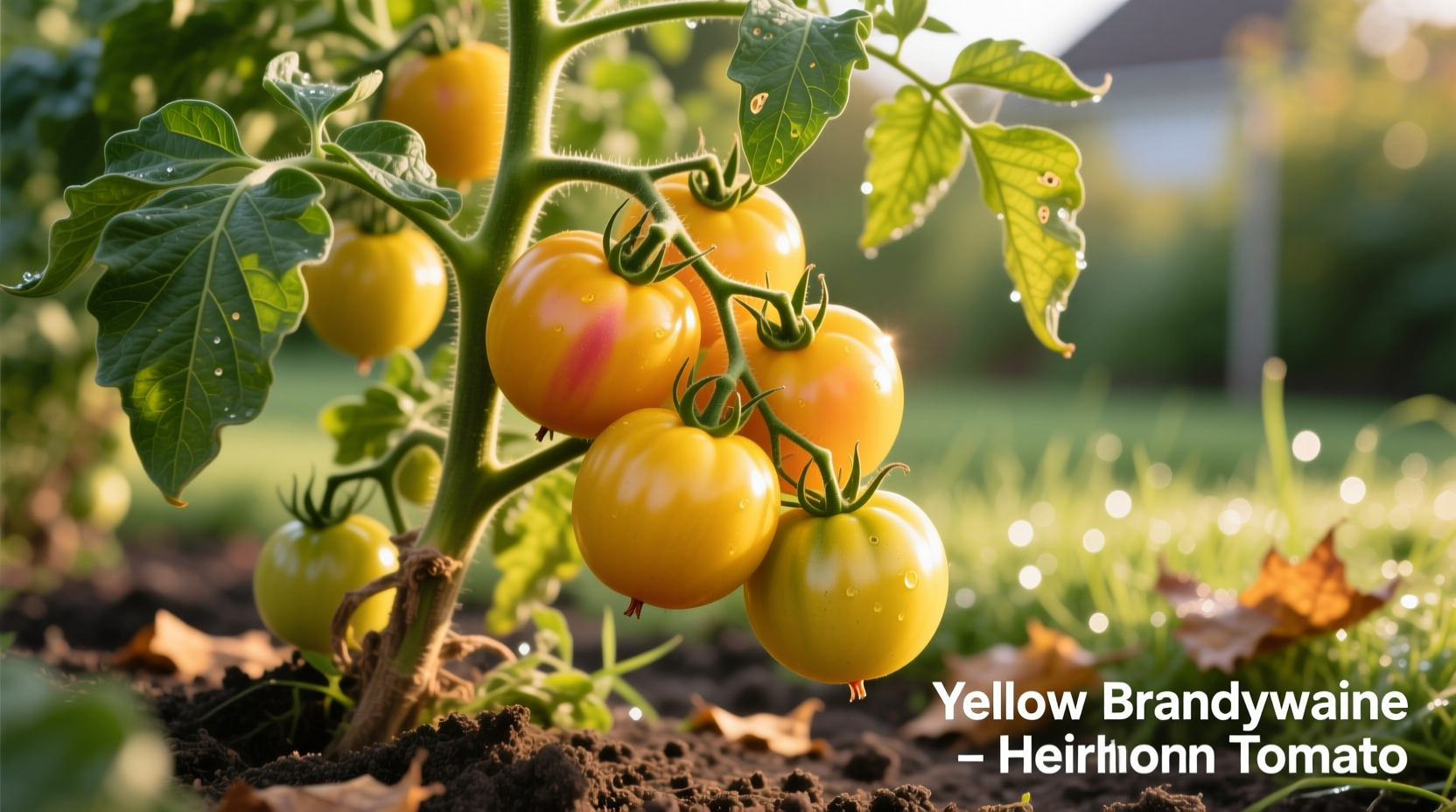Discover why Yellow Brandywine tomatoes have become a favorite among heirloom enthusiasts and home gardeners. Unlike standard red varieties, these golden gems offer a uniquely balanced flavor profile that combines sweetness with subtle citrus undertones, making them ideal for fresh eating, sandwiches, and gourmet salads. Their distinctive appearance—featuring golden-yellow skin with occasional pinkish streaks—adds visual appeal to any garden or plate.
What Sets Yellow Brandywine Tomatoes Apart
Yellow Brandywine represents a color variation of the famous Brandywine tomato, an heirloom variety believed to have originated with the Amish in the 19th century. While red Brandywines dominate the heirloom scene, the yellow variant offers distinct advantages for certain palates and culinary applications. These tomatoes typically weigh between 12-24 ounces, though some specimens can reach over two pounds under optimal conditions.
Gardeners consistently praise Yellow Brandywines for their complex flavor that lacks the sharp acidity of many red tomatoes. The flesh is dense and meaty with fewer seeds than standard varieties, providing more edible fruit per slice. When fully ripe, they develop a distinctive floral aroma that enhances their eating experience.
| Characteristic | Yellow Brandywine | Red Brandywine |
|---|---|---|
| Color at maturity | Golden-yellow with pink streaks | Deep pink to red |
| Flavor profile | Sweet, low-acid, fruity notes | Balanced sweet-tart, classic tomato |
| Acidity level | Low | Moderate |
| Best culinary uses | Fresh eating, salads, sandwiches | Sauces, canning, fresh eating |
| Disease resistance | Moderate | Moderate |
Optimal Growing Conditions for Success
Yellow Brandywine tomatoes thrive in warm climates with long growing seasons. These indeterminate plants require 80-90 days from transplanting to reach full maturity, making them suitable for USDA hardiness zones 3-9. For northern gardeners, starting seeds indoors 6-8 weeks before the last frost date ensures sufficient growing time.
When planning your garden layout, allocate at least 36 inches between plants with 48-60 inches between rows. These vigorous growers develop extensive root systems and tall vines that typically reach 6-8 feet in height. Unlike bush varieties, Yellow Brandywines require substantial support—use sturdy cages or trellising systems installed at planting time to prevent stem damage later.
Soil preparation proves critical for optimal growth. Incorporate 3-4 inches of well-aged compost into your planting area, aiming for a slightly acidic pH between 6.2-6.8. These tomatoes particularly benefit from consistent moisture, so implement drip irrigation or soaker hoses to maintain even soil moisture without wetting the foliage.

Seasonal Timeline for Yellow Brandywine Success
Understanding the seasonal progression helps maximize your harvest. In temperate climates, follow this timeline:
- Early spring (6-8 weeks before last frost): Start seeds indoors under grow lights
- Late spring (after last frost): Transplant hardened-off seedlings to garden
- Mid-summer: First flowers appear; begin regular feeding with balanced fertilizer
- Late summer: First fruits reach full size; monitor for ripening
- Early fall: Peak harvest period; continue harvesting until first frost
Gardeners in cooler climates may need to extend the season using row covers or cold frames as temperatures drop. The University of Minnesota Extension notes that tomatoes continue ripening off the vine when temperatures fall below 55°F (13°C), allowing you to harvest mature green fruits before frost and complete ripening indoors.
Common Challenges and Solutions
While Yellow Brandywines share many characteristics with their red counterparts, they present specific considerations. These heirlooms have moderate disease resistance compared to modern hybrids, making cultural practices essential for prevention.
Early blight and septoria leaf spot commonly affect Brandywine varieties. Prevent these issues by watering at soil level rather than overhead, removing lower leaves that contact soil, and rotating crops annually. The Cornell University Vegetable Disease Guide recommends copper-based fungicides as an organic option for managing fungal diseases when applied preventatively.
Cracking represents another challenge, particularly after heavy rains following dry periods. Maintain consistent soil moisture through mulching and regular watering to minimize this issue. If you notice blossom end rot (dark, sunken spots on fruit bottoms), this indicates calcium deficiency often caused by irregular watering rather than actual soil calcium levels.
Harvesting and Culinary Applications
Yellow Brandywines reach peak flavor when allowed to ripen fully on the vine until they develop their characteristic golden color with slight pink blush. Unlike red tomatoes, they won't dramatically change color near maturity, so check for slight softening and that distinctive floral aroma.
Their low-acid profile makes Yellow Brandywines particularly enjoyable for those sensitive to acidic foods. Food enthusiasts consistently rate them higher for fresh eating than cooking, though their meaty texture works well in salsas and fresh sauces. Try them in these applications:
- Sliced with fresh basil and mozzarella for a colorful caprese variation
- Chopped into grain salads where their sweetness balances hearty grains
- Blended into chilled summer soups with cucumber and dill
- Eaten simply with a sprinkle of sea salt to appreciate their complex flavor
When storing, keep harvested tomatoes at room temperature away from direct sunlight. Refrigeration diminishes flavor and texture, so only refrigerate if you must extend shelf life beyond a few days. For best results, consume within 3-5 days of picking.
Preserving the Heirloom Legacy
As an open-pollinated variety, Yellow Brandywine tomatoes allow seed saving to preserve this heirloom for future seasons. To collect viable seeds:
- Select fully ripe, disease-free fruits from your healthiest plants
- Scoop seeds and gel into a container with a small amount of water
- Ferment for 3-5 days at room temperature, stirring daily
- Rinse thoroughly and spread on paper to dry completely
- Store in a cool, dark place in labeled envelopes
Seed Savers Exchange, a nonprofit dedicated to preserving heirloom varieties, reports that properly stored tomato seeds remain viable for 4-6 years. By saving seeds from your best performers, you'll gradually adapt the variety to your specific growing conditions over time.











 浙公网安备
33010002000092号
浙公网安备
33010002000092号 浙B2-20120091-4
浙B2-20120091-4